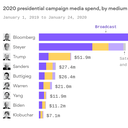Michael Bloomberg, Tom Steyer spend heavily on TV ads while other 2020 Democrats go digital

Published Date: 1/28/2020
Source: axios.com
Data: Advertising Analytics; Chart: Andrew Witherspoon/AxiosWhile some of the lower-spending 2020 Democrats are investing most of their dollars in digital ads, the biggest spenders — Michael Bloomberg and Tom Steyer — are overwhelmingly spending more on television ads as a percentage of their budgets. Why it matters: Their ad spend stands in stark contrast to that of the Trump campaign, which is investing much more heavily in digital advertising, especially on Facebook.Be smart: 2020 was supposed to be the year that digital got closer to overtaking television as a percentage of presidential campaign spend, and if it weren't for the two billionaires on the left entering the race, it very well may have been.Without those two candidates, all candidates (including Trump) in the past year have spent a collective $75 million on TV ads — roughly $60 million on broadcast and $15.5 million on cable — compared to nearly $80 million spent so far on digital ads. The big picture: The big critique of Democrats in 2016 was that the party was too reliant on consultants and an outdated organizational structure to invest enough in digital.Conversations with many sources in the political advertising world say that the same dynamic persists ahead of 2020. However, digital investments have increased overall, especially as candidates have found themselves under more pressure to solicit people online for small-dollar donations in order to qualify for debates.Yes, but: Democrats have pledged to pour many millions more into digital through third-party groups, and some candidates — like Pete Buttigieg and Elisabeth Warren — are still spending more online than on TV.A political action committee affiliated with the digital progressive group ACRONYM announced in November that it would launch a $75 million digital advertising campaign to take on President Trump. Priorities USA, one of the biggest progressive political groups, has spent roughly $7 million on digital ads over the past year. While Bloomberg's campaign has spent roughly $33 million to date on digital ads, it has pledged to spend up to $100 million throughout the course of his campaign in a digital anti-Trump ad blitz. Between the lines: Digital "acquisition" ads, especially on Facebook and Google search, are typically used to help campaigns build lists to lure small-dollar and volunteers. Video "persuasion" ads on platforms like YouTube and on local broadcast television, are usually used to get voters to cast ballots or take action on an issue. It's for this reason that broadcast spend tends to increase towards big primary events, like the Iowa caucuses and Super Tuesday, when candidates need voters to take action.